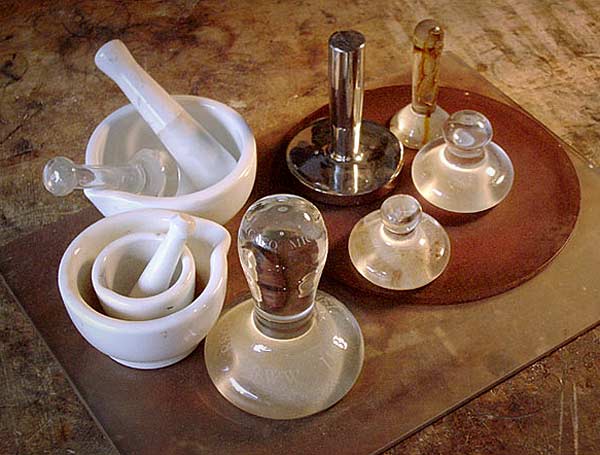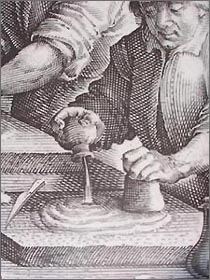Oil painting essential materials and techniques: Grinding Pigments

Oil painting essential materials and techniques:
Grinding Pigments
Grinding.—The color which the artist uses must be most evenly and perfectly ground. The grinding which will do for ordinary house paints will not do for the artist’s colors. Neither will the chemical processes suitable for the one serve for the other. Not only must the machinery, but the experience, skill and care, be much greater for artist’s colors. Therefore it is that the specialization of color-making is most important to good colors for the use of the artist.
Reliable Makers.—If you would work to the best advantage as far as your colors are concerned, both as to getting the best effects which pure pigments skilfully and honestly prepared will give you, and as to the permanency of those effects when you have gotten them, see to it that you get paint made by a thoroughly reliable colorman.
It is not my province to say whose colors you should use; doubtless there are many colormen who make artists’ materials honestly and well. Nevertheless, I may mention that there are no colors which have been more thoroughly tested, both by the length of time they have been in the possession of painters, and by the number of painters who have used them, than those of Winsor and Newton of London. No colors have been so generally sold and for so long a time, particularly in this country, as these, and none are so well known for their evenness and excellence of quality.
I do not say that these manufacturers do not make any colors which should not go on the palette of the cautious artist—I believe that they do not make that claim themselves; but such colors as they do assert to be good, pure, and permanent, you may feel perfectly safe in using, and be sure that they are as well made as colors can be. This is as much as can be said of any paints, and more than can be said of most. I have used these colors for many years, and my own experience is that they have always been all that a painter need ask.
The fact that Winsor and Newton’s colors can be found in any town where colors can be had at all, makes me the more free to recommend them, as you can always command them. This fact also speaks for the general approval of them.
Inasmuch as certain colors are not claimed to be permanent and others are, it is for you to compose your palette of those which will combine safely. This you can do with a little care. Some colors are permanent by themselves or with some colors, but not in combination with certain others. You should then take the trouble to consider these chemical relationships.
It is not necessary for you to study the chemistry of paints, but you may read what has been [Pg 39]ascertained as to the effects of combinations, and act accordingly. There are practically duplications of color-quality in pigments which are bad, and in pigments which are good; so that you can use the good color instead of the bad one to do the same work. The good color will cost more, but there is no way of making the bad color good, so you must pay the difference due to the cost of the better material, or put up with the result of using bad colors.




Thank you so much for this very extensive explanation..Thank you for taking the time to explain important details.